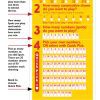Welcome to the thrilling world of poker! Ever wondered how to play poker like a pro? Well, you’re in luck because I’m here to guide you through a step-by-step video tutorial. So, grab your chips and get ready for an exciting journey into the game of poker!
In this video tutorial, we’ll cover everything you need to know, from the basic rules to advanced strategies. Whether you’re a complete beginner or have some experience playing poker, this tutorial will help you sharpen your skills and become a formidable player.
No need to worry if you’ve never played poker before. This tutorial is designed for players of all levels, including 13-year-olds like you! So, get ready to learn how to read your opponents, make smart decisions, and master the art of bluffing. Let’s get started on your path to becoming a poker pro!
- Start by learning the basic hand rankings.
- Understand the game rules, including betting and dealing.
- Learn the different poker variants, such as Texas Hold’em or Omaha.
- Watch video tutorials to observe real gameplay and strategies.
- Practice playing online or with friends to enhance your skills.
- Join local poker groups or events to gain experience.
- Remember, patience and practice are key to mastering poker!

How to Play Poker Video Tutorial: A Comprehensive Guide to Mastering the Game
Poker is a captivating card game that has been enjoyed by players for centuries. Whether you’re a beginner or an experienced player looking to enhance your skills, a video tutorial can be an invaluable resource. In this article, we will explore everything you need to know about playing poker through a video tutorial. From understanding the basic rules to mastering advanced strategies, we’ve got you covered.
1. Understanding the Basics
Before diving into a poker video tutorial, it’s crucial to grasp the fundamental aspects of the game. This includes understanding the hand rankings, different variations of poker, and the objective of the game. In a beginner-friendly video tutorial, you can expect to learn about the various actions you can take during a poker game, such as betting, folding, and raising. Additionally, basic terminology like blinds, community cards, and hole cards will be explained.
While watching the video tutorial, be prepared to pause and rewind as needed to fully absorb the information. Take notes on the key concepts and rules presented in the video to reinforce your understanding.
Remember, practice makes perfect. Once you have a solid foundation, start playing low-stakes poker games with friends or online to put your knowledge into action.
2. Mastering Poker Strategies
After grasping the basics, it’s time to dive deeper into the strategic aspects of poker. A comprehensive video tutorial will cover a range of strategies, including starting hand selection, position play, and bluffing. These strategies can help you gain an edge over your opponents and make more informed decisions.
One of the key benefits of learning through a video tutorial is the ability to witness real-life examples and scenarios. The tutorial may showcase hand analyses, illustrating how different strategies can be employed in different situations. By observing experienced players in action, you can develop a better understanding of optimal decision-making and improve your own gameplay.
As with any skill, becoming proficient in poker requires practice and patience. Use the knowledge gained from the tutorial as a foundation and continually refine your strategies by playing regularly. Analyze your gameplay, study the actions of other skilled players, and adapt your approach accordingly.
3. Advancing to Advanced Techniques
Once you have a firm grasp on the basics and have honed your strategies, you can move on to exploring more advanced techniques. In an advanced poker video tutorial, you can expect to learn about topics such as hand reading, range analysis, and advanced mathematical concepts.
Hand reading involves deciphering your opponents’ likely holdings based on their actions and the community cards on the table. This skill can be invaluable in making accurate predictions and making strategic decisions.
Range analysis is another crucial aspect of advanced poker play. By considering the possible hands that your opponents could have based on their actions, you can narrow down their range and make more informed choices.
Additionally, an advanced tutorial may delve into mathematical concepts such as pot odds, implied odds, and expected value. These concepts can help you make more precise calculations when deciding whether to call, raise, or fold.
Additional Tips for Learning Poker through Video Tutorials
1. Take Advantage of Interactive Features
Many video tutorials offer interactive features, such as quizzes or exercises, to enhance the learning experience. Make sure to engage with these features to test your understanding of the material presented and reinforce your knowledge.
2. Seek Community and Expert Guidance
While video tutorials are a fantastic tool for learning poker, don’t underestimate the value of community and expert guidance. Join poker forums or communities where you can engage with fellow players and experts to exchange insights, ask questions, and further develop your skills.
3. Practice Bankroll Management
Proper bankroll management is essential for any poker player, whether you’re a beginner or an advanced player. Set aside a dedicated poker bankroll and ensure you play within your means. This will help you brush off any losses and keep your emotions in check, enabling you to make rational decisions during gameplay.
In conclusion, a video tutorial is an excellent resource for anyone looking to learn or enhance their poker skills. From understanding the basics to mastering advanced strategies, these tutorials provide the knowledge and insights needed to excel at the game. By utilizing these resources and practicing regularly, you can become a skilled poker player and experience the thrill of this captivating card game. So, grab your deck of cards, find a reliable video tutorial, and get ready to embark on an exciting journey into the world of poker!
Key Takeaways:
- Poker is a popular card game that involves strategy, skill, and a bit of luck.
- The objective of poker is to have the best hand or to convince other players to fold.
- The game consists of several rounds of betting and the players must make decisions based on the cards they have and the actions of other players.
- There are different variations of poker, such as Texas Hold’em, Omaha, and Stud, each with its own rules and gameplay.
- It’s important to understand the basic poker hand rankings, as these determine the strength of your hand and whether you have a chance of winning.
Frequently Asked Questions
Welcome to our guide on How to Play Poker Video Tutorials! Whether you’re a beginner or looking to improve your skills, we’ve got you covered. Below are some frequently asked questions to help you get started on your poker journey.
1. What are the basic rules of poker?
Poker is a card game played with a standard deck of 52 cards. The objective is to have the best hand at the end of each round. Each player is dealt a certain number of cards, depending on the type of poker being played. Players make bets based on the strength of their hand or the confidence they have in winning the pot.
The game progresses with each player taking turns making decisions, such as folding, checking, calling, or raising. The round ends when all players have either folded or made their final bets. The player with the best hand wins.
2. What are the different types of poker games?
There are several types of poker games, each with its own set of rules and gameplay. Some popular variations include Texas Hold’em, Omaha, Seven-Card Stud, and Five-Card Draw. Texas Hold’em is the most widely played variant, known for its strategic gameplay and community cards.
In Omaha, players are dealt four hole cards instead of two, and they must use exactly two of their hole cards and three of the community cards to form the best hand. Seven-Card Stud involves players receiving a combination of face-up and face-down cards, with betting rounds in between. Five-Card Draw is a simpler variant, where each player is dealt five private cards and can choose to replace some or all of them.
3. Can you explain the concept of bluffing in poker?
Bluffing is an important strategy in poker. It involves making bets or raises with a weak hand to deceive your opponents into thinking you have a strong hand. The goal is to make your opponents fold, allowing you to win the pot without having to show your cards. However, bluffing is a risky move and should be used judiciously.
Successful bluffing requires careful observation of your opponents’ behavior and betting patterns. It’s important to choose the right moments to bluff and to consider the dynamics of the game. Experienced players master the art of bluffing and use it to their advantage, but it’s important to note that bluffing won’t guarantee success in every situation.
4. How can I improve my poker skills?
Improving your poker skills takes time and practice. Start by learning the rules of the game and understanding the various strategies involved. Familiarize yourself with hand rankings and betting patterns. There are numerous resources available, including books, online tutorials, and video lessons, that can help you sharpen your skills.
Additionally, playing regularly and gaining practical experience is essential for improvement. Joining a local poker club or playing online can provide opportunities to test your skills against other players. Analyzing your gameplay, studying your opponents’ moves, and reflecting on your decisions can also contribute to your growth as a player.
5. Are there any tips for managing my bankroll effectively?
Bankroll management is crucial in poker to ensure you don’t risk more money than you can afford to lose. One common rule is the “5% rule,” which suggests that you should never risk more than 5% of your total bankroll on a single game or tournament. This helps protect your bankroll from significant losses.
Another tip is to set strict spending limits and stick to them. It’s essential to have a clear understanding of your financial situation and play within your means. Avoid chasing losses and know when it’s time to walk away. Managing your bankroll responsibly allows for a more sustainable and enjoyable poker experience.
How to Play Poker
Summary
So, now you know the basics of playing poker! Remember, it’s a game of skill and strategy. Practice, learn from your mistakes, and have fun! Don’t forget to manage your bankroll wisely and always play responsibly. Good luck on your poker journey!









